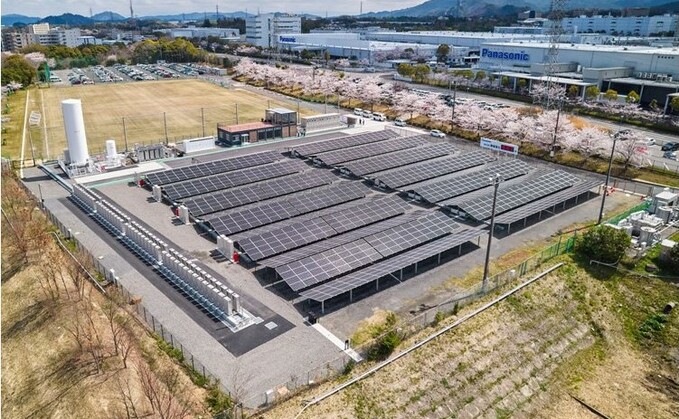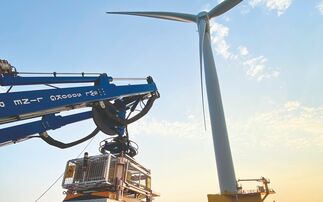
The H2 Kibou Field | Credit: Panasonic
A cutting-edge hydrogen fuel cell-based power plant at a Japanese manufacturing plant could provide a decarbonisation template for other industrial sites to follow
At a production plant for hydrogen fuel cells in central Japan, Panasonic is on a mission to prove energy-intensive factories around the world can operate with zero emissions by harnessing a combination of hydrogen, batteries, and renewable energy.
The Kusatsu site has long been a hotbed of hydrogen innovation. Fuel cell systems that generate high-efficiency electricity and heat for residential buildings using fossil gas have been produced at the factory for 13 years. And last autumn, commercial production started at the site on Panasonic's next generation fuel cell product, lightweight 5kW fuel cell units that produce electricity for commercial facilities directly from hydrogen gas. Panasonic claims the 'H2 Kibou' systems have the highest electrical efficiency of any similar product on the market today, and are able to generate electricity for up to five days without refuelling.
And now, Panasonic is putting its fuel cell generators to a very public test, at the exact site where they are manufactured. Last month, the tech giant switched on operations at the H2 Kibou Field, a power plant for the Kusatsu fuel cell factory that combines 99 H2 Kibou generators, 1.1MWh of lithium-ion battery storage capacity, and 570kW of photovoltaic solar generators. The resulting power plant, which also includes a hydrogen storage tank, covers the entirety of the fuel cell factory's power needs.
While H2 Kibou Field is currently operating on grey hydrogen, produced with fossil gas, the plan is to transition the site to green hydrogen, which is produced with zero emissions using renewable power, water, and electrolysis. As such, the tech giant claims the H2 Kibou Field as the first in the world to prove that all the electricity consumed by a factory can be powered by renewable sources through the "full-scale use" of hydrogen.
Senior executives from Panasonic's fuel cell business told BusinessGreen the Kusatsu plant had been the obvious place to build a demonstration plant that tested and showcased the potential of the very fuel cell technologies produced just a stone's throw away.
"Panasonic is one of the biggest fuel cell manufacturers worldwide and has shipped more than 250,000 units from this Kusatsu factory since 2009," said Shinsuke Morita, head of Panasonic's European fuel cell business. "We have the technology which can intake green hydrogen and produce electricity. This, and Panasonic's commitment to carbon neutrality across its own operations by 2030, was the reason we chose to test carbon-neutral production at this site. "
Morita reiterated that the company intends to switch the H2 Kibou Field on to green hydrogen within a few years, when a more ready and constant supply of the green fuel becomes available. "It is quite difficult to get big and steady amounts of green hydrogen right now," he said. "So, we have started with non-green hydrogen, but we will switch as soon as possible."
Production of renewable hydrogen remains minimal around the world, and its cost is currently higher than ‘grey' or ‘blue' alternatives produced with fossil fuel feedstocks, even in Japan, one of the most advanced hydrogen economies in the world. However, the cost differential has narrowed in recent months as global fossil gas prices have soared and green hydrogen developers remain confident their costs have the potential to fall significantly. The hope is that bold low carbon hydrogen targets introduced in recent years by a number of industrialised economies will combine with falling renewables costs, and increasing investments in electrolyser technology to drive down the cost of the zero emission fuel. And this, in turn, could enable companies like Panasonic to switch their operations away from fossil fuel derived hydrogen.
After a two-year testing period at the H2 Kibou Field is complete, Panasonic intends to sell the solutions to other companies around the globe that are looking to decarbonise their manufacturing sites from 2023.
The tech giant is clearly banking on significant appetite for the technology as manufacturers look for decarbonisation solutions that can protect them from both carbon pricing regimes and expensive and volatile wholesale electricity prices. Many manufacturers are increasingly tapping renewables with batteries to decarbonise their plants, but there are limits to how much of an energy-intensive factory's power needs can be generated on-site through renewables alone.
Panasonic maintains the solution on display at Kusatsu can complement existing on-site renewables technologies and enable factories to decarbonise all their operations without the need to build out large energy parks. "Due to the combination of PV and battery storage and pure hydrogen/fuel cell systems, even companies that don't have as much space surrounding their premise to build up huge PV farms for sufficient green electricity supply will have the chance to produce their green electricity on location," explained Teva Laou-Hap, Panasonic's head of industry, new business and technology in Europe. "The only externally purchased fuel would be green hydrogen."
The H2 Kibou Field spans 6,000 square metres, making it a bit smaller than a single football pitch. Panasonic said it had purposefully built on a surface area roughly equivalent to the building area of the Kusatsu factory, in order to highlight how it could in theory have fit on the factory's rooftop.
Panasonic also maintains that hydrogen fuel cell power systems offer energy stability, flexibility, and maintenance benefits that standalone renewables-plus-storage systems do not. Not only does the hydrogen-heavy set-up reduce operators' dependency on weather-dependent renewable energy generation, but each hydrogen fuel cell power unit can be controlled individually. Ths means that the overall system's power output can be carefully optimised in line with a factory's energy requirements and weather conditions, it said. The overall time each unit spends in operation can be evened out to reduce variation in total operating time and minimise wear on the generators, while maintenance on units can be performed without any dirsuption to power generation.
"This Kusatsu project is a test case for Panasonic to see whether energy intensive processes like a manufacturing site in Europe can become carbon neutral by the use of Panasonic's setup consisting of PV, batteries and fuel cells, all managed intelligently by Panasonic's energy management system," Laou-Hap said. The company is also developing an energy optimisation system which crunches weather forecast data, power demand data, and equipment monitoring data to optimise the output from the hydrogen fuel cells, balancing any excess or shortage of power with the on-site energy storage capacity.
Now that the site is operational, the plan is to run tests for two years to check the fuel cells and energy management system work as expected. "We need to collect data first and see how the set up proves stability of power supply throughout the annual and seasonal variances," Morita said.
If all goes well, the expectation is that Panasonic will start offering its "full-scale" factory decarbonisation solution to other companies in the coming years, Morita added. "If all works out well, we aim to roll this set-up out to some other Panasonic factories within this decade to expand the variety of manufacturing needs and tests," he explained. "Commercialisation to external companies could be in similar timeframes."
This article is sponsored by Panasonic, a partner of the Net Zero Innovate Hub.










